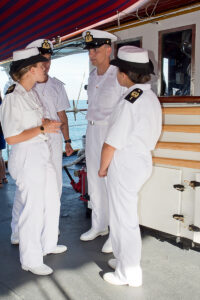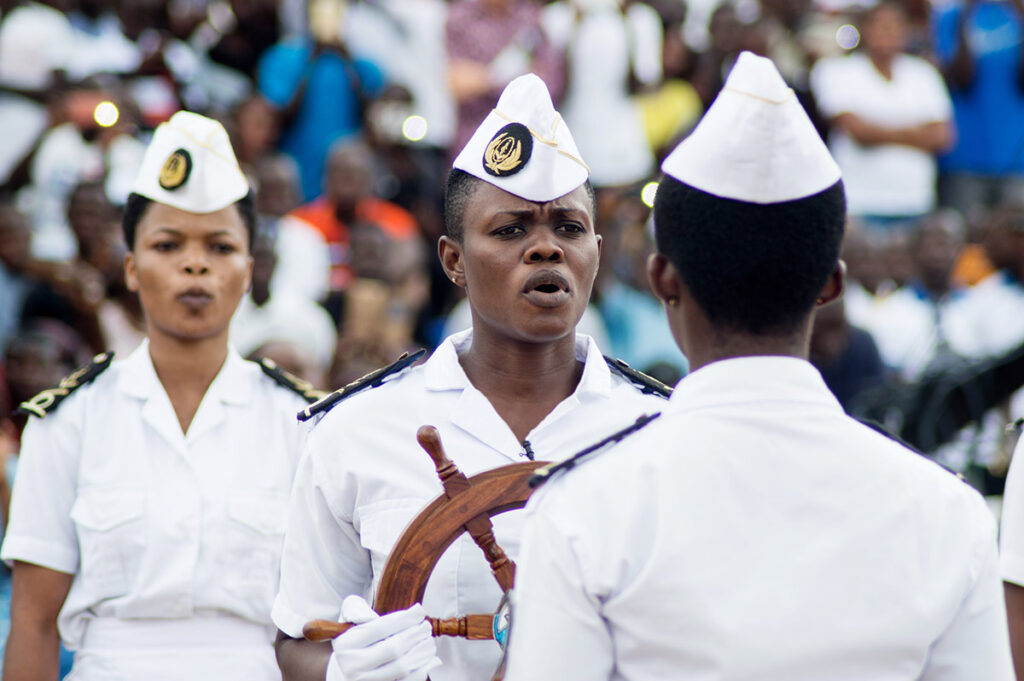Barriers preventing employment of women should be removed
By Rawle Baddaloo
Women have been employed in the maritime sector for an extremely long time. While it is very difficult to give very specific examples, my own observations and those of my colleagues in the 1950s and 1960s in the Eastern European Countries, Soviet Bloc and China are of female deck, engine and catering personnel.
 When I first went to sea in the mid-1960s, the entire catering staff on the Norwegian tanker that I sailed on was female. The western flags and particularly the British were slow in moving in this direction. In the military however it was different, as women had been serving for decades. It is in marine facilities where employment of women has taken an inordinately long time.
When I first went to sea in the mid-1960s, the entire catering staff on the Norwegian tanker that I sailed on was female. The western flags and particularly the British were slow in moving in this direction. In the military however it was different, as women had been serving for decades. It is in marine facilities where employment of women has taken an inordinately long time.
In looking at the employment of women for sea-going duty, the first stumbling block is vessel design. While one gender can comfortably share personal care facilities like bathrooms and toilets, it is uncommon for both genders to share the same facilities. In fact, in some jurisdictions it is illegal. I remember many years ago in a panel discussion where emerging female mariners indicated that this was a poor excuse. One had to go to great length to explain that while it may be comfortable for some willing to share facilities, there is a law. And, if anything untoward occurred, the ship owner and Master would be charged or even imprisoned.
Night Work Act
In many jurisdictions (particularly those that were British), laws that remained after the attainment of political Independence prevented positive change to allow women to break the proverbial glass ceiling. And here I refer specifically to the Employment of Women (Night Work) Act. This law had its genesis in an ILO Regulation dating back to 1939. (The specific part of the Night Work Act stated that women were not to take up duty on night shifts. This in effect stopped the recruitment of women to do shift work which is the basis of all sea going HR structures.)
This proved to be a huge stumbling block. In fact, in many jurisdictions it was ignored. In Trinidad and Tobago it was repealed on February 17, 2006 when the Occupational Safety and Health Act (OSH Act) was passed. This legislation of Trinidad and Tobago made specific reference to the 1939 Act.
 Women being employed were in many cases treated indifferently. Meritocracy has always been my guide. However, the web and printed publications show a proliferation of situations in which women were subjected to inhumane treatment. And they were regularly bypassed or ignored when opportunities for promotion came along.
Women being employed were in many cases treated indifferently. Meritocracy has always been my guide. However, the web and printed publications show a proliferation of situations in which women were subjected to inhumane treatment. And they were regularly bypassed or ignored when opportunities for promotion came along.
In the mid-1970s, the first British Texaco female cadets took up their assignments on board. As Chief Officer, I was honoured to have the care and mentoring of these young cadets entrusted to me. Before the ease of communication in today’s world, going to sea and the length of voyages were daunting. Now it is less so and numerous female cadets and officers are serving on the full range of vessels if the accommodation allows it.
Sadly, however, ship and shore employment figures show only 29% of women being employed in the marine sector. And only 2% of percent of sea-going personnel are women. Notwithstanding the low numbers there is a commitment to change by the International Maritime Organization (IMO). Recently (May 18, 2022) the IMO declared the first International Day for Women in Maritime.
New talent
In the words of one participant during those celebrations “… for us, gender equality is, in the most direct sense of the word, a question of sustainability for the maritime sector. Put more bluntly, it is a question of economic survival! Why is that? The simple answer is: Rampant workforce inequalities and instability are becoming barriers that prevent the industry to access the resources it needs. So, the sector is struggling to attract new talent and tapping into the second half of the population is becoming an imperative.”
The situation in the wider Caribbean is lack of information. Maritime Education is open to few. Maritime subjects are not on the standard school syllabus. More than 15 years ago, I embarked on an education project targeting the 14 and above age group in the secondary school system. The aim was to increase the cadet intake at the tertiary institution. It was magical. From just a few young persons applying, the numbers rose to levels where class sustainability and continuity were no longer issues. Admittedly, there is some momentum now but this is still not enough.
 There are other jobs in the system, not only sea-going. Land-based employers such as ports administrations, government ministries, shipping agencies, ship owners and operators, freight forwarders and others need to be proactive and work with shipping associations, chambers of industry and commerce and tertiary institutions to look at training and course content and then address exposure and recruitment.
There are other jobs in the system, not only sea-going. Land-based employers such as ports administrations, government ministries, shipping agencies, ship owners and operators, freight forwarders and others need to be proactive and work with shipping associations, chambers of industry and commerce and tertiary institutions to look at training and course content and then address exposure and recruitment.
Tertiary Institutions that deliver undergraduate and postgraduate courses are receiving more female students. What is also encouraging is the well-balanced staff at these institutions. Indeed, my alma mater, the IMO’s World Maritime University in Malmo, is led by the Caribbean barrister, Doctor Cleopatra Doumbia-Henry from Dominica. These trends will hopefully encourage more women get qualified for maritime careers.
Improving
The collection of data on gender equality and, more so, the general employment of women in maritime industries is improving. The IMO has been working to address gender imbalance for 30 or more years. Under this umbrella eight thriving Women in Maritime Associations (WIMAs) have been formed. There are three Associations in Africa, and one each in the Arab States, Asia, Latin America, the Pacific and the Caribbean (WiMAC).
Modern vessel design allows for the employment of women. Privacy on board is protected. The job is no longer one in which brawn is needed. Women have taken up jobs as marine pilots in many parts of the world. This dangerous occupation has experienced a gradual increase in the employment of women.
It is clear that the numbers of women in maritime industries is growing. The trailblazers however cannot and must not sit back and reflect on the successes. Many unfortunate incidents are still being swept under the proverbial carpet. The focus must be on meritocracy, mentoring and management. Appropriate laws are in place. Ship design is facilitating mixed gender crews. The Maritime Authorities led by the IMO are working assiduously to encourage employment of women in the maritime sector. The senior members of the fraternity must now take on the responsibility of mentoring. Flag states must remove all barriers that could prevent the employment of women. Nothing should bar qualified women from grasping opportunities and rising to the senior-most positions in the maritime sector. []
- First published: 2023, May 1






